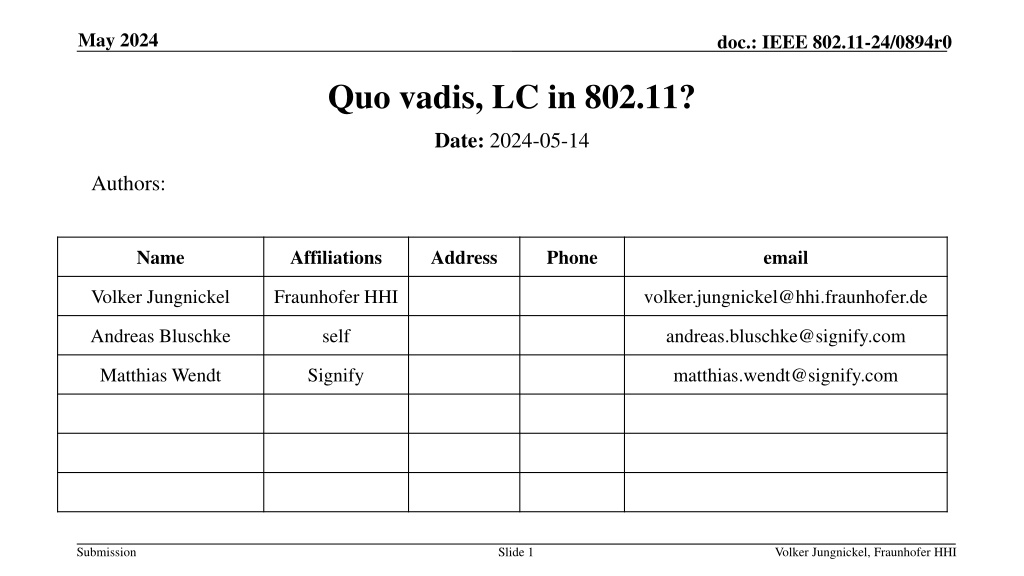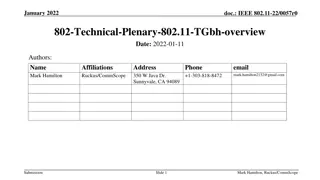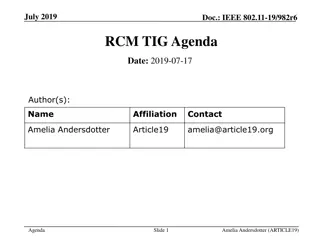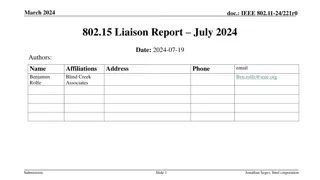Evolution of Integrated Light Communication in IEEE 802.11
Recent discussions in IEEE 802.11 focus on the evolution of Light Communication (LC) to meet market needs and technological advancements. The proposal suggests forming a study group to define parameters for Integrated Light Communication (ILC) to enhance mass market adoption.
Download Presentation

Please find below an Image/Link to download the presentation.
The content on the website is provided AS IS for your information and personal use only. It may not be sold, licensed, or shared on other websites without obtaining consent from the author. Download presentation by click this link. If you encounter any issues during the download, it is possible that the publisher has removed the file from their server.
E N D
Presentation Transcript
May 2024 doc.: IEEE 802.11-24/0894r0 Quo vadis, LC in 802.11? Date: 2024-05-14 Authors: Name Affiliations Address Phone email Volker Jungnickel Fraunhofer HHI volker.jungnickel@hhi.fraunhofer.de Andreas Bluschke self andreas.bluschke@signify.com Matthias Wendt Signify matthias.wendt@signify.com Submission Slide 1 Volker Jungnickel, Fraunhofer HHI
May 2024 doc.: IEEE 802.11-24/0894r0 Abstract This contribution summarizes recent discussions in 802.11 on LC evolution, taking market needs and recent developments into account. The proposal is to form a study group to define the PAR and CSD for Integrated Light Communication (ILC). Submission Slide 2 Volker Jungnickel, Fraunhofer HHI
May 2024 doc.: IEEE 802.11-24/0894r0 Current status of LC Recent IEEE LC standards finished IEEE Stds 802.15.13-2023 and 802.11bb-2023 focusing on industrial applications and mass market [1, 2] LC gained traction in various niche markets, where light has unique selling points Military, secure conference rooms (governments, banks): LC cannot be wiretapped/jammed fixed wireless access: LC goes through windows (no outdoor unit), LC can offload traffic from RF platooning, train-to-train: LC is not interfered by RF (reliable channel access, suitable for wireless control) Chicken-and-egg problem (No chipset = No market / No market = No chipset) Both new IEEE LC standards compete with ITU-T Rec. G.9991 (legacy of G.hn) ITU-chipset allows simpler integration with LC optical frontends, 802.11bb needs costly up-down conversion 802.11bb is likely to become single-vendor scenario. But standards should enable interoperability How to make IEEE LC standards more attractive for mass market adoption? Submission Slide 3 Volker Jungnickel, Fraunhofer HHI
May 2024 doc.: IEEE 802.11-24/0894r0 Previous developments related to LC Recently proposed new features Distributed MIMO [3] Integration of LC and RF [4] Integration into MLO [5] and with mm-wave [6] Higher bandwidth (320, 640, MHz): Non-overlapping channels [7] Reuse original BB for sub-7 GHz or up-clocked BB for mm-wave [8] Unified IF interface for LC and mm-wave [9], new wavelength for LC [10] LC to continue as separate project IMMW supporters did not want to risk extending the scope that was backed up by a 802.11 WG Motion Issues to be regarded towards new LC study/task group will run in parallel to two mainstream projects (11bn, immw) offload contributions into teleconferences Submission Slide 4 Volker Jungnickel, Fraunhofer HHI
May 2024 doc.: IEEE 802.11-24/0894r0 Proposed scope of new project Make LC more attractive for mass market adoption 1. Native support for LC IF Solve chicken-and-egg problem specify LC IF interface in more detail interoperability of LC optical frontends with any 802.11 chipset (infrastructure and device side) taking EMI concerns seriously into account 2. Enable new features in 11be and 11bn for LC Integrate LC deeper with 802.11 320 MHz (and possibly more), integration into MLO, coordinated multi-AP Develop 802.11bb further into generic LC spec.: transport any 802.11 version over light 3. Support of distributed MIMO for LC Improve reliability (LOS blockage), reduce latency centralized infrastructure chipset based on 802.11, distributed optical frontends specify electrical/optical fronthaul interface over diverse media (CATx, POF, PLC, FttR) consider amplify-and-forward vs. decode-and-forward approaches Submission Slide 5 Volker Jungnickel, Fraunhofer HHI
May 2024 doc.: IEEE 802.11-24/0894r0 Summary The evolution of LC in 802.11 should focus onto features which primarily make LC more attractive for mass market adoption. This contribution has summarized previously proposed features and suggested priorities towards the above mentioned goal, which maybe further detailed in new study group. Submission Slide 6 Volker Jungnickel, Fraunhofer HHI
May 2024 doc.: IEEE 802.11-24/0894r0 Straw Poll Do you support the creation of an Integrated Light Communication (ILC) study group that will be tasked with the creation of a PAR and CSD for a standards project to specify operation of 802.11 in optical bands between 800 nm and 1550 nm and simplify the integration with LC optical frontends? Y / N / A Submission Slide 7 Volker Jungnickel, Fraunhofer HHI
May 2024 doc.: IEEE 802.11-24/0894r0 References [1] IEEE Std 802.11bb-2023, https://standards.ieee.org/ieee/802.11bb/10823/ [2] IEEE 802.11-23/0277r1 IEEE 802 Tutorial IEEE 802 Standards on Light Communication March 2023 Plenary Meeting [3] IEEE 802.11-23/0091r New Light Communication Features [4] IEEE 802.11-23/1068r0 Experiment Results with Wi-Fi to Li-Fi Offloading in an Office Environment, [5] IEEE 802.11-23/0221r1 Hybrid LC and RF in UHR [6] IEEE 802.11-23/2016r2 Extend IMMW scope to include optical bands [7] IEEE 802.11-24/0062r0 Channelization to include optical bands [8] IEEE 802.11-24/0077r0 Numerology to include optical bands [9] IEEE 802.11-24/0406r1 Unified IF interface for mm- and light-wave [10] IEEE 802.11-24/0571r0 March 2024 LC proposal [11] IEEE 802.11-23/0098r0 WNG Meeting Minutes 2023-Jan Baltimore meeting Submission Slide 8 Volker Jungnickel, Fraunhofer HHI























